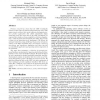Free Online Productivity Tools
i2Speak
i2Symbol
i2OCR
iTex2Img
iWeb2Print
iWeb2Shot
i2Type
iPdf2Split
iPdf2Merge
i2Bopomofo
i2Arabic
i2Style
i2Image
i2PDF
iLatex2Rtf
Sci2ools
ISCA
1995
IEEE
1995
IEEE
Instruction Fetching: Coping with Code Bloat
Previous research has shown that the SPEC benchmarks achieve low miss ratios in relatively small instruction caches. This paper presents evidence that current software-development practices produce applications that exhibit substantially higher instruction-cache miss ratios than do the SPEC benchmarks. To represent these trends, we have assembled a collection of applications, called the Instruction Benchmark Suite (IBS), that provides a better test of instruction-cache performance. We discuss the rationale behind the design of IBS and characterize its behavior relative to the SPEC benchmark suite. Our analysis is based on trace-driven and trap-driven simulations and takes into full account both the application and operating-system components of the workloads. This paper then reexamines a collection of previously-proposed hardware mechanisms for improving instruction-fetch performance in the context of the IBS workloads. We study the impact of cache organization, transfer bandwidth, pr...
| Added | 26 Aug 2010 |
| Updated | 26 Aug 2010 |
| Type | Conference |
| Year | 1995 |
| Where | ISCA |
| Authors | Richard Uhlig, David Nagle, Trevor N. Mudge, Stuart Sechrest, Joel S. Emer |
Comments (0)

